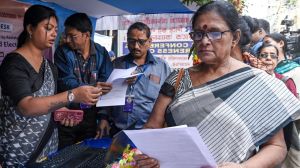Santosh K Singh’s The Deras: Culture, Diversity and Politics recovers the syncretic, if male-dominated, character of these sacred spaces in Punjab
In the state's Jat-Sikh-dominated society, Valmikis and Chamars rarely found representation. Deras occupied this vacuum. They offered the marginalised shelter, spatiality to counter the caste hegemony and legends of Ambedkar and Ravidas.

Roland Barthes, in his book Mythologies, underlined how a sign is stripped of its original meaning and is imbued with a new, mostly ideological, connotation to produce “myths”. In this process, what gets lost is the essence and core values of the original sign. In a predominantly social-media-driven society, such slippages happen more often. The limited understanding of Dera – otherwise, a place of political and socio-religious congregation laced with multipolarity and syncretism– through the image of Dera Sacha Sauda and its imprisoned-but-furloughed-multiple-times chief Gurmeet Ram Rahim Singh, feeds such myths. In his recent book The Deras: Culture, Diversity and Politics (Penguin, 2025), sociologist Santosh K Singh busts these myths about dera and rediscovers its contested, multilayered characters through nuanced ethnographic intervention.
In Punjab and the adjoining states, deras, run under Gurus, have gradually become the space of cultural and political churning, mostly dominated by marginalised communities. Though Sikhism’s foundational principle abolished casteism in letters, it survived in spirit. Punjab’s 32 per cent SC population, the highest in the country, gives testimony to it. Still, in the Jat-Sikh-dominated socio-political structure, Valmikis and Chamars rarely found representation. In this political vacuum, the deras found its space. On the one hand, it offered the marginalised shelter, on the other, it gave them legends of Ambedkar and Ravidas to mobilise and counter the caste hegemony.
Singh, in his book, traces back the root of this journey to the emergence of Babu Mangoo Ram and his Ad-Dharmi movement that sought to establish a separate religious identity for Dalits in Punjab in the early twentieth century. However, in the later years, with many deras embracing Ravidassia identity, celebrating the words and legends of the sixteenth-century poet and saint, the demand for a separate religion got diluted. Rather, places like Dera Ballan became the space of syncretic and inclusive religious interactions where Sikh Maryada and Guru Granth Sahib were given due respect without interrupting the authority of the resident Guru.
This syncretism, however, is not devoid of other sociological factors like class and spatiality. In 2009, when Sant Ramanand was killed in Vienna allegedly by Sikh extremists, the demands for leaving Sikhism grew among a section of Dera Ballan devotees – mostly the financially strong NRIs. They also composed a new religious book. But such an attempt failed due to the “cultural grains of the region” and its “sacred sensibilities”. Singh’s nuanced ethnography brings to the fore the perceptive differences between classes of devotees. While the local followers were not in much favour of such separation, due to many pragmatic reasons – ranging from their historical connection to Sikhism to the fear of unnecessarily provoking the dominant Jat-Sikh groups – the NRIs were adamant. The stark difference between the special compartment assigned to the NRIs and the bogeys kept for local devotees in Begampura Express that carries devotees every year to Ravidas temple at Varanasi, a project that was largely funded by the former and is considered to be a pilgrimage for Dalits, reveals the prevalent class cleavages. Singh’s exploration of intra-caste tensions between Valmikis and Chamars also reflects on the contested space that otherwise gets invisibilised in surface-level analysis of deras.
While Singh’s ethnography, building on serendipity and curiosity instead of preconceived notions or targeted objectives, cracks open the complexities of Dera’s politics, his overemphasis on Indic religion and its civilisational values of syncretism reinforces problematic binaries like that of Indic-alien/ syncretic-conservative faiths. The book is also silent about the absence of women Gurus in Dera. Except for an oblique reference to the poor sex ratio of Punjab, the book doesn’t explore the masculine nature of Deras. Written in a lucid language for the common audience, this narrative ethnography is a sociological-historical account of deras beyond its connection to Ram Rahim whom the author rightly calls “entrepreneurial Baba”.
- 01
- 02
- 03
- 04
- 05






























